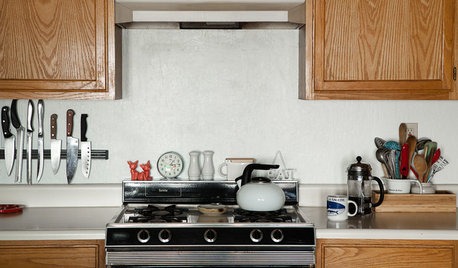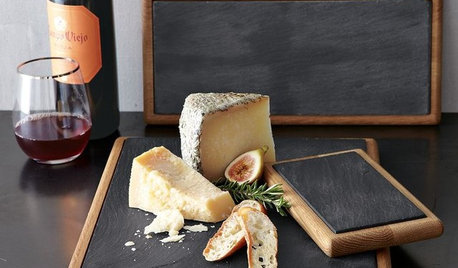What are worms favorite food
Yes,dose anyone knows, what best favorite food is for worms?,,,,,,Thanks greg
Comments (47)
newbie314
18 years agoSupposedly no favourite.
But mine love Watermelon, oh yeah
High sugar, lots of water, they love it.I guess it's like us swimming in a pool of pudding :-P
They clean those rinds easily in 2 weeks. I can't even tell what they are, but at least I keep a log to keep track.
Have fun. No meat, diary usually, but mine has handled a peanut butter sandwich (not cut up either).
Related Professionals
Londonderry Landscape Architects & Landscape Designers · Wrentham Landscape Architects & Landscape Designers · Waunakee Landscape Architects & Landscape Designers · Wayland Landscape Contractors · Wilton Landscape Contractors · Four Corners Landscape Contractors · Amarillo General Contractors · Champaign General Contractors · Deer Park General Contractors · Genesee General Contractors · Greensburg General Contractors · Jefferson Valley-Yorktown General Contractors · Kilgore General Contractors · Lakewood General Contractors · Nampa General Contractorschuckiebtoo
18 years agoEvery single time I have the perfect answer, both clinically and factually, for a fellow poster, damned if Kelly hasn't already put in her two cents...er, million bucks, worth of information before I get a chance to compose mine. And her answer is ALWAYS exactly what I was gonna say.
That being said, all the more reason to LOVE BSF larva, which (who?) don't worry about decomposition to start. They are precomposters for my worms. You gotta love em. However, since I've moved several bins into the garage, my wife has noticed "these little armadillo-looking BUGS crawling around" in the house...not many, just a few. "WHAT ARE THESE THINGS", she demanded!!!!. "Damned if I know", I said.
Worming indoors at my house makes necessary a certain amount of bald-faced lying most of the time. The rest of the time requires generous amounts of creative explanation.
Also critter lookout at all times before she might find something foreign to her idea of a safe and secure civilized environment.Chuckiebtoo
sqh1
18 years agochuckiebtoo..I have been thinking..uh oh..because I too have many indoor bins and those BSF's will leave the bins looking for a dry, dark place to pupate. Can we come up with,perhaps,a collection bin, below the working bin that the BSF's would find acceptable. That collection bin could be emptied somewhere more desirable, (ie: not inside). I have read somewhere that the larvae have difficulty going in, I think, a vertical direction. I have had them indoors for years now, during winter. I think I get all of the larvae, as I see them on the floor, but I am always very wrong. When things warm, there are always 4-5 every day flying around. This invention would be a great thing. Soon as your wife stops getting ready for the tra la la holidays, perhaps you could help me think of a way to work this out, (or anyone else reading this post).
gregstep
Original Author18 years agoThanks,so much,,,,,Great imformation....I was thinking about using alfalfa tea.3 cups to a 5 gallon bucket...and let it set for 2 day.I have heard that worms are crazy over alfalfa tea,,,,,,greg
Priswell
18 years agoThat being said, all the more reason to LOVE BSF larva
You can't make me like them. Nope. Can't. Make. Me. ;-)
trancegemini_wa
18 years agoI was going to say anything really soft and watery, but that doesnt mean they wont eat other things but they get through salad scraps like lettuce very quick, but I would have to say that pears have been my worms favourite, if I stick an overripe pear on top, the next time I visit the bin they are just clustered underneath it, they love their pears :)
garnetmoth
18 years agoI am also curious about the tea. It would be buying alfalfa to add, which is not necessary. If you think it will help the microbe load, it might? I dont know, but unless youre just barely misting it, you could get the bin too wet, which will make it stinky.
If you just have crumbled grain foods or moist/chopped fruit and veg scraps on occasion, your bin should get an added kick without buying any additional items.
Worms have been doing this much longer than us.tumbleweed56
18 years agoWhat Kelly said makes a lot of sense, but, how come the worms love coffee grounds so much. Do the protozoa go after coffee grounds just as fast as they would a watermelon?
jason_mackenna
18 years agoI'd asked this on another thread -- but if worms eat the bacteria, protozoa, mold & fungi, then why no meat or dairy products. Dairy molds up like crazy, and meat is chock full o' bacteria after a few days in a nice worm bin. It would seem that this high bacteria food would be WONDERFUL for worms.
vmpalmerton
18 years agoFirst of all don't put corn cobs, banana peels, orange peels, any meats or dairy products in your worm bins. Not unless you grind it up first, but you're still better off not to put any animal products in it. Save anything from your kitchen and throw it into the bin. I keep a short shovel and make sure I just break everything up when I put it into the bins. They really love coffee grounds if you can collect them from a coffee house. They'll usually give them to you for free.
Kelly_Slocum
18 years agoFirst, regarding tea; Garnetmoth is spot on, tea is not going to amplify system biology beyond what can be supported by the food resources present. An environment of decomposing organic matter has a finite amount of food resources that will ultimately limit the number of organisms, both macro and micro, it can support (though this limited population will still exceed several million organisms per gram). Tea is an innoculum of micororganisms, but very little food resource, thus you are adding microbes to the bin, but nothing on which they can live for an extended period of time. The result is typically a temporary spike in biological enumeration that fairly quickly returns to the levels supported by the system prior to tea application. There is no valid research demonstrating that adding tea to a well run worm bin will amplify the biological activity among either the microbes or the worms.
Neither, however, is it likely to harm anything in the bin to add good tea, and there are many people who do so and swear that it makes their bins operate more efficiently. So, if it feels right to you, go for it!
Tumbleweed, yes, bacteria like coffee grounds because coffee grounds have lots of surface area by virtue of their somewhat small particle size, have a nice balance of carbon and nitrogen, and are damp but chunky, meaning lots of moisture in the presence of lots of air. Huge populations of bacteria will grow in the grounds, attracting and supporting huge populations of the protozoa that prey on bacteria. A few fungal species generally join the party along with the odd rotifer (algae) that also appreciates the moisture and you can see that coffee grounds are a lovely substrate for supporting worm activity!
Jason, the prohibition against meat and dairy products has nothing to do with their being problematic for worms (despite the erroneous claims one can read on the internet and in some books that worms are vegetarians), rather it is we humans who find such feedstocks potentially challenging. Because the worm cannot ingest meat or dairy until it rots, and because the smell of rotting meat and dairy is distasteful to humans but highly attractive to vermin and houseflies, the inclusion of these materials can cause problems with bins kept in or near human living spaces. While these challenges CAN be managed, and some folks do include some meat, fats and cheeses in their bins, the general statement is to avoid these materials to ensure the bin is user friendly.
Grinding feedstock can certainly decrease decompostion time in the bin provided the ground material does not become compacted and anaerobic. Many people swear by this practice, but many more add bananas, orange peels and corn cobs whole or in large chunks and find they are very effectively, if more slowly, processed. Both of these options are frequently used and very effective!
KellyS
newbie314
18 years agoNo problem with Bananas. They love them.
I freeze them sometime.
Put a PB&J sandwich in once.Kelly_Slocum
18 years ago::giggling over the menatl image of newbie314's worms with peanut butter stuck to the roofs of their little mouths::
KellyS
AbbeysDad
18 years agoBased on this thread and that we just happened to have some old watermellon and cantelope, I chopped it up, and put it in a trench across the middle of the bin and lightly covered it.
By the next day or so it was warm as toast and just beneath it was full of worms. I wasn't really expecting the slight temperature increase although it signals biological activity. The mass is small enough I think where this shouldn't be an issue, especially since the worms could retreat if they felt the need. But right now it seems they're all at the party and who knows what all is going on since all the chaparones are drunk on sugar laden protazoas.
It's clear to me that decomposing fruit seems like a popular food.newbie314
18 years agoWhen I bury watermelon, I stack the rinds so they create lots of air pockets.
Can tell from the surface the watermelon is being consumed by the sinking of that area of the bin.socks
18 years agoI'm still a little confused as to exactly what the worms are eating. I need an elementary school explanation! LOL!
Would it be correct to say that worms eat microscopic organisms (protozoa, fungi and algae) and also the kitchen scraps, etc. once they have begun to decompose?
AbbeysDad
18 years agoPerhaps more precisely, (as Kelly wrote) the worms ingest the decaying organic matter in order to extract nutrition from the bacteria, protozoa, fungi, etc. that feed on the organic matter.
Worms are like ALF looking at the decaying organic (salad) matter..."that's not food, thats what food eats!"
"Here kitty kitty"
LOL
lori_ny
11 years agoThis page says that worms do not like acidic things to eat:
http://www.ehow.com/list_6796723_foods-do-earthworms-prefer_.html
So I wonder why they like coffee grounds? They would be extremely acidic! I just put a bunch of sliced tomatoes into my veggie row's soil and now I wonder if they are too acidic for a worm to eat:(
Lori
sbryce_gw
11 years ago"These worms tend to avoid citrus peels, onions and garlic, hot peppers and foods high in acid, which may poison them or cause digestive problems."
My worms loved citrus peels, they like onion peels well enough, and they loved tomatoes. They liked coffee grounds after they had a chance to go moldy.
I think we make far too much of the "acidic" issue. In practice, I have never seen it be a problem.
GreenIvy
11 years agoI think mine like watermelon the best. Put it in the bin and stand back! :)
I haven't had any problems with onions, curry or salsa. My worms seem to love tomatoes; BFF had a load of nasty ones from his garden and I've been chucking them into the bin. Might be a varietal thing?
I do think a load of strawberries is what kicked my bin into anaerobic conditions, but because of the moisture not the acidity. Coffee grounds seem to be ignored, but tea bags go quickly.
Celbrise
11 years agopeople seem to give theirs a bunch of fruits and they love them.
i am sure water melon is one of the top fruits as it's water which worms as also and it's sweet and sugary. i have given my millipedes water melon before they alone loved it. i have heard/seen cantaloup never tried it.
but really they will eat just about anything organic. they don't seem picky. i feed mine a mixture of rotten banana's, lettuce, bread, spices from spice rack that are old, old vegetables basically and loads of it. they eat it and don't seem to mind it.
only problem i do have is my bin heats up when i feed them for the first couple days even when the food is pre rotted so i try to only feed one side so the other side is cool/cold.
colin3
11 years agoLori_NY: If you search the forum you'll find lots on coffee grounds. Grounds seem to be only mildly acidic and to get even less so under composting conditions. Coffee grounds are about 1/4 of my vermicompost inputs by volume.
e.g.
http://faq.gardenweb.com/faq/lists/soil/2002015354019975.htmlalso
http://www.puyallup.wsu.edu/~linda%20chalker-scott/horticultural%20myths_files/Myths/Coffee%20grounds.pdf
http://www.sciencedaily.com/releases/2008/07/080707171641.htm
http://www.sunset.com/garden/earth-friendly/starbucks-coffee-compost-test-00400000016986/
http://groundtoground.org/2011/03/05/ph-of-soil-from-coffee-grounds/As Kelly Slocum points out upthread the worms are only the top feeder, so to speak, after a lot of other organisms have had a go and transformed the inputs in various ways. Sbryce, just above, is absolutely right. Just dump stuff in and let it rot. It will be fine. People way over-worry this.
lori_ny
11 years agoColin and others,
Thanks for the wonderful links and info:) I work in a restaurant and will start bringing them home tomorrow.
Lori
JerilynnC
11 years agoI'll second what sbryce said. The acid isn't a big deal. Besides, if you are throwing in some crushed egg shells the calcium carbonate will buffer any of the occasional acidy things you toss in.
Wormsome
11 years agoi had a bad experience with some tomatoes and lemon rinds one winter.
overly acidic environments will inhibit bacteria growth and encourage molds.
coupled with an excess of moisture from the tomatoes and coffee grounds...well lets just say i never, ever want to be scraping worms off a cement floor again.
i was in a hurry and missed a few lemon rinds/tomatoes. this and i didn't attend to my bins for almost two weeks. while i was away the bin turned white with mold. it was bad! i felt terrible!
worms are very forgiving but i failed them on a few different levels. i don't mean to be contradictory only to offer this anecdote as a cautionary tale.
w
sbryce_gw
11 years agoCautionary tales are fine. Every bin is different. If your experience is different than mine, then someone else's will be too. It is good to see both sides, then make your best decision for your own bin. Anything new to your bin should be approached with caution until your worms adjust.
Shaul
11 years agoThings I feed my worms: Watermelon, Cantaloupe, Avocado, Strawberries, Peppers (not Hot Peppers), Cucumbers, Grapes, Dates, Kiwi, Pumpkin, Bananas, Oranges and Grapefruit (on occasion), Apples, Pears, Coffee Grounds.
Shaul
equinoxequinox
11 years agoShaul: Tell me it is the scraps or cuttings or kitchen waste of these items you are using for vermicomposing. That is the benefit of vermicomposting is it uses waste. Old, outdated whole produce would be a benefit to reuse. Everything has a best use, humans. a secondary use animals or chickens, and a final use, compost for everything. The key is to use everything for its highest use.
buckstarchaser
11 years agoBeing winter, I'm catching a lot of mice in traps. They go straight into the bin with whatever urine I have with me. Since it is cold outside, I only want to feed higher energy things and not water them with low food value water that will only cool them down. The more biological heating I can get, the more active my worms will be over the winter and the more worm dirt and large worms I'll have in the spring. I hope to start the process of shrinking them this next year so that I can have an unstoppable worm army of my own.
I just dug around in the bin and I could not find any mice in there. There are worms and fur in the area though, and it didn't smell like urine, ammonia, or dead mice (I used to raise mice for pet stores... dead ones have an unforgettable smell).
The food chain in my house usually dictates that my dog gets food that I don't want to eat, but for anything I wouldn't even feed my dog... That's the worm's "favorite food"... or they can shut up and eat their cardboard.
Shaul
11 years agoHi Equinox;
Of course it's the peels, cores, and other (possibly) rotting fruits and vegetables that go into the bins. Occasionally, if I see something on sale and knowing it's a favorite, I may actually buy it fresh. Whatever else we generate, like meat, dairy, onions, garlic, chili peppers, and citrus peels (in quantity), goes to the city compost recycling program.
Shaul
steander57
11 years agoHi all,
Good reading in the above posts, but I have not seen any mention of paper. i have been lead to believe shredded newspaper is fine to put into the worm bins, and office printing paper is not fine to put in as there are extra chemicals from the manufacturing process which could be harmful to the worms.
Can anyone confirm that i am correct, or can i put in any paper or cardboard if it is shredded.Steve.
thedogsLL
11 years agoI have used any paper that has no gloss/shiny side to it or color. The less ink the better, I think. but black ink in moderation seems to be okay. I've only been doing this for a bit over 3 months but a layer of shredded paper, mixed with cut up heavier stuff like egg cartons, toilet paper and paper towel roll centers, plain brown paper bags (especially after being used a couple times to store mushrooms for some reason) all seem to work well to soak up moisture and keep worms happily eating and squirming around.
buckstarchaser
11 years agoI use all papers that don't appear to have waterproofing or excessive preservatives in them. Shiny, colored, newspaper, printer paper, bills, food boxes, and corrugated cardboard. If it will absorb water then it is a generally good paper to me and my worms. I do avoid packaging that was used to hold metal parts with machine oil on them though.
My worms seem to respond well to wood chips whether they are freshly ground by me or the small, dark chips I get from the local hardware store. The wood won't compact, holds water, nutrients and air very well, and I read a while back that the lignins in wood (and paper) are one of worm's preferred foods. Supposedly the worms produce a chemical that stimulates plants to produce more lignin too. That means that the presence of worms has a technical reason for making plants grow more.
I think a lot of people are unaware of what 'horrible' things they pay good money to put on their gardens while throwing much milder things in the trash to keep it out of the dirt they are making to dump on the dirt in the 'garden'. An immaculately kept garden is absolutely not cleaner or less toxic than the funny pages with their colored newspaper ink.
islandschool
11 years agoThanks for all the info.
My worms have been in the bin for 5 days now. But I've noticed when I was digging around they were eating the old moldy onions, but they did not eat the citrus peels so I've picked those out.
We're a college level education program and we produce about 20 pounds of food waste per day. I'm hoping to get the worms eating it all.
We're composting now but it takes months for the stuff to break down, too much vegetable mass not enough green mass.
I've chucked in a couple shovel fulls of our compost and a lot of shredded cardboard. They are still 'exploring' the area but only a few rogues here and there now.
I'm concrened about the long term heat problems, we're in zone 13a I think. It's the cool season and it's still above 80 every day.
I'm gonna try to maybe ice down the bin as needed, at least a couple big pieces of ice broken up when it's really hot. But for now all seems well.
thedogsLL
11 years agoHmm, buckstarchaser, that's food for thought. I have avoided colors on paper because, with the exception of my local newspaper, I have no way of knowing if they are petroleum based or soy/veggie based, and I don't want petroleum based stuff in my garden or in my food. (I'm not strictly organic, just trying to stay healthy.)
This is probably a topic for a different thread, so I'll just say that my worms get salad like leftover/gone bad lettuce, radish, tomato, cucumber, plus beans, summer squash, fruit leftovers, some different veggies that I buy to try and if I don't like them the worms will.
:)
Lynn
buckstarchaser
11 years agoLynn: There is petroleum in all newspaper inks that I'm aware of. The soy based inks use paraffin to set the ink. Paraffin and mineral oil are petroleum based and are common machine lubes in the food industry and very commonly found on food as a coating to prevent moisture from being gained or lost with the environment, as well as in home canning (directly in contact with food). Mineral oil is also a common baby laxative. I don't suggest that newspaper ink is printed with any food-grade petroleum products, but rather suggest that the air you are breathing contains more petroleum products per ounce than compost made with newspapers. Also note that if you spray anything on your plants that can be described as horticultural oil or soap... you're almost certainly applying petroleum products directly to your food.
Islandschool: Orange peels may break down slowly by default because they come from from a tropical environment where biology is in overdrive. They have a natural waxy coating to seal the fruit from drying quickly and are filled with a harsh oil to help prevent being eaten before the seeds develop. They are high in the antioxidant vitamin-C which guards them against cellular damage that could be capitalized upon by rot organisms. Store-bought oranges often are coated with additional BHT or paraffin wax to extend their moisture retention. I have not experimented with orange peels to find out a way to quickly rot them as I live in zone 5 and they are not plentiful here. If I had to guess how to compost them, I would think to mix them with things that are good at absorbing oil, such as paper and cardboard. Grinding them will expose more oil to be absorbed away, and heat will help liquify the oils and waxes. The acidity could be negated with dolomite lime (which seems to be good for plants and worms anyway) or even water that had ashes soaking in it... I searched for how to compost orange peels and came up with a thread on it for you.
Here is a link that might be useful: Orange peels - composting.
islandschool
11 years agoThanks, we've got them segregated out of the compost but in the same big bin just not where I'd scoop them up for the worm. I'll give them a try in a separate bucket when I can fish one out of somewhere.
grstamping
6 years agoI have read somewhere that freezing the ingredients first will brake down the cells and accelerate the decomposition process so I keep a tray in the freezer where I add items and take them out a few hours before freezing. The banana peels become gooey and brown and I cut them in small bits and the worms are better able to enjoy them. I also freeze all the Keurig cup and I am better able to remove the coffee grind when frozen. I am working on my first bin. Started in July and just cultivated about 10L of compost. I am too excited about my worms so I check on them often -every day or two. I feed them every 3-5 days. I have a small bin and don't overfeed. I was hoping I could keep them in the garage for the winter here in Canada. Does anyone have suggestions to keep them warm, without heater. I have the option to bring them in the house, but the spot in the garage is convenient and easy access.
grstamping
6 years agoShaul - in July I got 1/2 LB of European night crawlers. I also got the living composter from a farmer the company is called Cathy's Crawly Composters
Shaul
6 years agoHere's what I do. This system has worked for me for a number of years. My bins are outside and this has kept them toasty warm through sub-freezing temperatures with snow on the ground. My two Rubbermaid-type plastic bins sit on a wooden table. I found a small wooden pallet almost the exact same size as the table. I placed the pallet on the table and the two bins on top of the pallet. In between the tabletop and the pallet I snaked Rope Light (x-mas light). The rope light contains tiny incandescent bulbs (not LED's) and gives off heat. The Rope Light is rated at 16w/meter. I have 5 meters=80 watts (try holding an 80 watt light bulb. It gets pretty hot). The bins on the pallet block most of the openings between the slats. Whatever other openings, I blocked off with pieces of styrofoam. The heat from the Rope Light has nowhere else to go except up into the bins. To regulate the temperature in the bins, I installed a Dimmer switch between the electric and the Rope Light. Using simple long-stemmed dial-reading Oven thermometers in the bins and using the dimmer switch, I can adjust the temperature from 0 to 80 watts. The worms are happy and the system is simple and cheap. Here are some links to past discussions on Winter heating.
http://forums.gardenweb.com/discussions/2209647/rope-lights-for-heating-shaul?n=5
http://forums.gardenweb.com/discussions/2192798/heated-worm-bin?n=23
Emily Leuba
6 years agoWould some sort of insulation help? Straw bails around the bin, or old styrofoam coolers?
















Kelly_Slocum